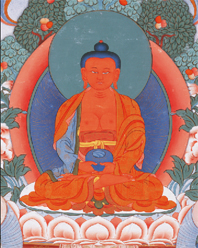Phowa: Difference between revisions
mNo edit summary |
|||
| Line 1: | Line 1: | ||
[[Image:Amitabha.jpg|frame|[[Amitabha]] (''from a [[thangka]] in the personal collection of [[Sogyal Rinpoche]]'')]] | [[Image:Amitabha.jpg|frame|[[Amitabha]] (''from a [[thangka]] in the personal collection of [[Sogyal Rinpoche]]'')]] | ||
'''Phowa''' (Skt. ''saṃkrānti''; Tib. འཕོ་བ་; [[Wyl.]] ''‘pho ba'') is the practice for directing the transference of consciousness at the time of death, either for oneself or another. The consciousness may be transferred to the [[dharmakaya]] nature, to a [[pure realm]] such as [[Sukhavati]] or to a favourable existence in the human realm. The practice is one of the [[Six Yogas of Naropa]], but is also to be found in many other lineages and systems of teaching, including the [[Longchen Nyingtik]] and [[Namchö]] cycles. Although it is included among the so-called '[[five practices of enlightenment without meditation]], it does require a thorough training before it can be put into effect successfully. Moreover, the teachings advise that phowa for others should only be undertaken by someone who has reached the [[path of seeing]]. | '''Phowa''' (Skt. ''saṃkrānti''; Tib. [[འཕོ་བ་]]; [[Wyl.]] ''‘pho ba'') is the practice for directing the transference of consciousness at the time of death, either for oneself or another. The consciousness may be transferred to the [[dharmakaya]] nature, to a [[pure realm]] such as [[Sukhavati]] or to a favourable existence in the human realm. The practice is one of the [[Six Yogas of Naropa]], but is also to be found in many other lineages and systems of teaching, including the [[Longchen Nyingtik]] and [[Namchö]] cycles. Although it is included among the so-called '[[five practices of enlightenment without meditation]], it does require a thorough training before it can be put into effect successfully. Moreover, the teachings advise that phowa for others should only be undertaken by someone who has reached the [[path of seeing]]. | ||
==Subdivisions== | ==Subdivisions== | ||
Revision as of 10:34, 1 February 2011

Phowa (Skt. saṃkrānti; Tib. འཕོ་བ་; Wyl. ‘pho ba) is the practice for directing the transference of consciousness at the time of death, either for oneself or another. The consciousness may be transferred to the dharmakaya nature, to a pure realm such as Sukhavati or to a favourable existence in the human realm. The practice is one of the Six Yogas of Naropa, but is also to be found in many other lineages and systems of teaching, including the Longchen Nyingtik and Namchö cycles. Although it is included among the so-called 'five practices of enlightenment without meditation, it does require a thorough training before it can be put into effect successfully. Moreover, the teachings advise that phowa for others should only be undertaken by someone who has reached the path of seeing.
Subdivisions
Tsele Natsok Rangdrol lists five kinds of phowa:
| This section contains Tibetan script. Without proper Tibetan rendering support configured, you may see other symbols instead of Tibetan script. |
|
|
Patrul Rinpoche mentions another list of five kinds of phowa:
- Superior transference to the dharmakaya through the seal of the view
- Middling transference to the sambhogakaya through the union of the generation and completion phases
- Lesser transference to the nirmanakaya through immeasurable compassion
- Ordinary “phowa of three recognitions”: recognition of our central channel as the path; recognition of our consciousness as the traveller; and recognition of the environment of a buddha realm as the destination.
- Transference performed for the dead with the hook of compassion
In the Dzogchen teachings, two kinds of transference are sometimes mentioned:
|
|
Notes
Phowa Teachings & Transmissions Given to the Rigpa Sangha
- Tulku Pegyal Rinpoche was the first teacher to give Amitabha empowerments and teachings to the Rigpa sangha for the practice of phowa from the Longchen Nyingtik tradition. He did this on several occasions.
- Chagdud Khadro has also given the Rigpa sangha Amitabha empowerments and taught the phowa practice of Longsal Nyingpo on different occasions.
- Mingyur Rinpoche, Lerab Ling, 11-12 September 2010.
- Sogyal Rinpoche, San Diego, 2-4 December 2010.
- Sogyal Rinpoche, Kirchheim, 3-4 January 2011.
Further Reading
- Chagdud Khadro, P’howa Commentary, Pilgrims Publishing, India, 2004
- Sogyal Rinpoche, The Tibetan Book of Living and Dying, Ch. 13 & 14.
